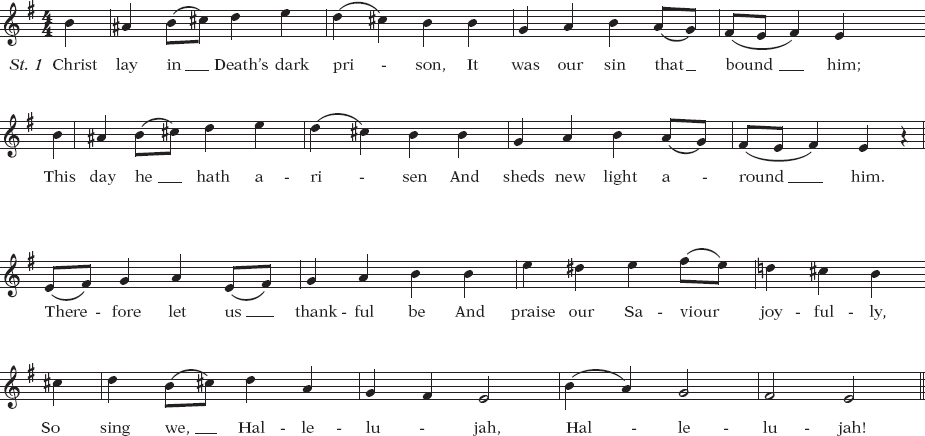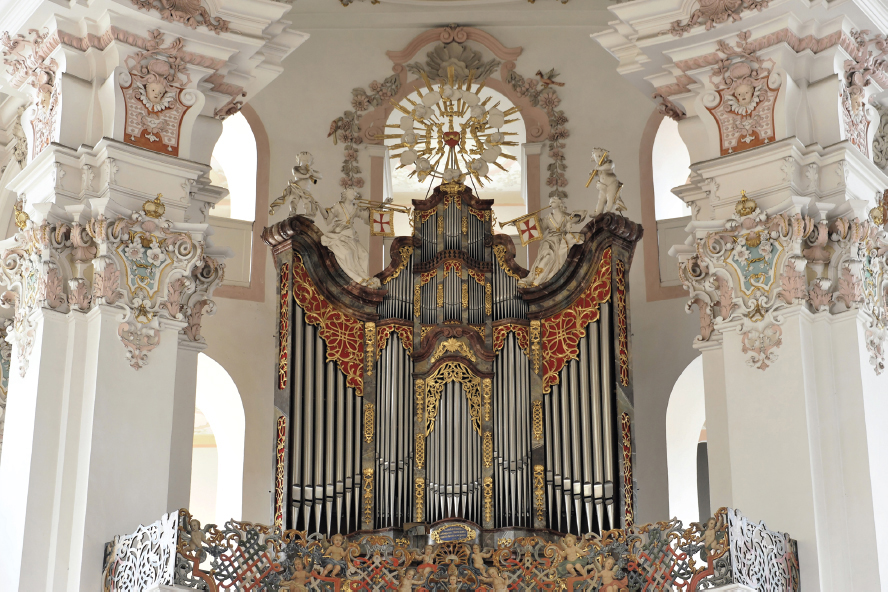Johann Sebastian Bach (1685–1750), Cantata No. 4, “Christ lag in Todesbanden” (1707)
In his positions as an organist and cantor, Bach made multiple settings of many hymns. We will study just one of his settings of the Easter chorale “Christ lag in Todesbanden” (Christ Lay in Death’s Dark Prison).
This rugged old tune, given below in its entirety, had been fitted with even more rugged words by Martin Luther himself, in 1524. The seven stanzas of the chorale, each ending with “Hallelujah!,” tell in vivid language of mankind’s struggle with Death and the victory achieved through Christ’s sacrifice. The fact that this hymn is in the minor mode throws a tough, sober shadow over all the rejoicing; the mood is unforgettable.

LISTEN
“When Bach seated himself at the organ, he used to choose some theme and treat it in all the various forms of organ composition. First, he used this theme for a prelude and fugue, with the full organ. Then he showed his art of using the stops for a trio, quartet, etc., on the same theme. Afterwards followed a chorale, the melody of which was playfully surrounded by the same theme in three or four contrapuntal parts.”
Bach the improviser, from the earliest biography, 1802
The cantata based on “Christ lag in Todesbanden,” one of Bach’s earliest, employs simple forces: voices and a string orchestra, with continuo. The words of the seven movements are Martin Luther’s words of the seven stanzas of the famous Easter chorale.
Bach set these seven stanzas with a sharp eye (or ear) for symmetry. Not all of the voices sing in all of the stanzas. The following diagram tallies the voices that sing in each one, with the shading indicating which voices sing the chorale melody itself.
| SINFONIA | STANZA 1 | 2 | 3 | 4 | 5 | 6 | 7 | Color shading indicates which voice sings the chorale melody. (In stanza 6, it is divided between two voices.) |
| Orchestra | Soprano | S | S | S | S | |||
| Alto | A | A | A | |||||
| Tenor | T | T | T | T | ||||
| Bass | B | B | B |
After a short orchestral prelude — Bach calls it “sinfonia,” or symphony — all the stanzas except the last are set as gapped chorales of some sort.
Stanza 3 The tenor sings the gapped chorale tune; follow him along with the music on page 147. Accompanied by the continuo (played on the organ), a violin plays an urgent melody at both ends of the piece and in the gaps between the lines. At the word nichts (“nothing”) the music comes to a wrenching stop and a slowdown, a quite astonishing effect. Then the violin starts up again as though nothing had happened. The sudden absence of music tells us what is left of Death’s power: nichts, zilch!
Stanza 4 Here it is the alto (doubled by organ) that sings the gapped chorale tune, more slowly than the tenor of stanza 3. The continuous music is assigned to the other voices singing faster imitative polyphony to the same words. Their music always uses fragments of the chorale melody; in this way Bach works the old chorale even into his own, newly composed music. Perhaps all this busy imitative polyphony makes a good illustration of the warfare described with such gusto in this stanza. Perhaps, too, the jaunty rhythm at Ein Spott can indeed be heard as mocking Death, who has lost his sting.
Stanza 7 No longer gapped, this is a straightforward presentation of the hymn as it might be sung by the congregation. Bach’s rich harmonies below the soprano melody are sung by the lower voices, doubled by the instruments. The cantata comes to a restful conclusion at last, as the text turns from battles to the confidence of faith. Even “Hallelujah!” can now be uttered simply.

LISTEN
Bach, “Christ lag in Todesbanden”
| Stanza 3: Jesus Christus, Gottes Sohn, | Jesus Christ, the Son of God, |
|
| An unser Statt ist kommen, | Has come on our behalf, | |
| Und hat die Sünde weggetan, | And has done away with our sins, | |
| Damit den Tod genommen | Thereby robbing Death | |
| All’ sein Recht und sein’ Gewalt; | Of all his power and might; | |
| Da bleibet nichts — denn Tod’s Gestalt; | There remains nothing but Death’s image; | |
| Den Stach’l hat er verloren. | He has lost his sting. | |
| Hallelujah! | Hallelujah! | |
| Stanza 4: Es war ein wunderlicher Krieg, | It was a marvelous war |
|
| Da Tod und Leben rungen; | Where Death and Life battled. | |
| Das Leben da behielt das Sieg, | Life gained the victory; | |
| Es hat den Tod verschlungen. | It swallowed up Death. | |
| Die Schrift hat verkündiget das | Scripture has proclaimed | |
| Wie ein Tod den andern frass; | How one Death gobbled up the other; | |
| Ein Spott aus dem Tod ist worden. | Death became a mockery. | |
| Hallelujah! | Hallelujah! | |
| Stanza 7: Wir essen und leben wohl | We eat and live fitly |
|
| Im rechten Osterfladen. | On the true unleavened bread of Passover; | |
| Der alter Sauerteig nicht soll | The old yeast shall not | |
| Sein bei dem Wort der Gnaden. | Contaminate the word of grace. | |
| Christus will die Koste sein | Christ alone will be the food | |
| Und speisen die Seel’ allein, | To feed the soul: | |
| Der Glaub’ will keins andern leben. | Faith will live on nothing else. | |
| Hallelujah! | Hallelujah! | |